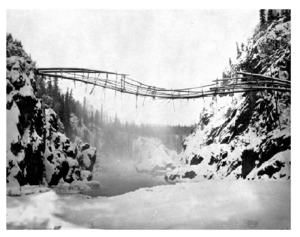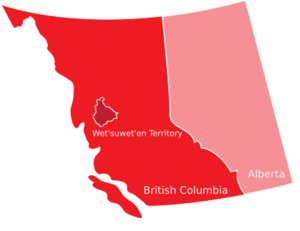Wetʼsuwetʼen facts for kids
 |
|
| Total population | |
|---|---|
| approx. 3,160 (2019) | |
| Regions with significant populations | |
| Canada (British Columbia) | |
| Languages | |
| English, Babine-Witsuwitʼen | |
| Religion | |
| traditional beliefs |

The Wetʼsuwetʼen (pronounced wet-SOH-ih-tin) are a First Nation group in Canada. They live in the central part of British Columbia, near the Bulkley River and around several lakes. Their name, Wetʼsuwetʼen, means "People of the Wa Dzun Kwuh River," which is another name for the Bulkley River.
The Wetʼsuwetʼen are related to the Dakelh or Carrier people. They speak a language called Witsuwitʼen. This language is part of the larger Babine-Witsuwitʼen language family. It is also connected to the Athabaskan language group.
Their ancient stories, called kungax, tell of an old village named Dizkle or Dzilke. This village was located along the Bulkley River. The stories say the village was left because of a warning of trouble. The exact spot of this village is now unknown.
Contents
Wetʼsuwetʼen Clans and Leaders
The Wetʼsuwetʼen have a special way of organizing their community. They have five main groups called clans. These clans are then divided into thirteen smaller groups called house groups.
Hereditary Chiefs
Each house group has a main leader known as a house chief. There are also several sub-chiefs who help. These leadership titles are usually passed down through families. A chief often chooses their successor. Clan membership is passed down from the mother to her children. Male hereditary chiefs are called dinï zeʼ', and female hereditary chiefs are called tsʼakë zeʼ'.
The tables below show the different clans and their house groups. They also list the traditional chief names and the current chiefs.
| House group | Translation | House chief name | Incumbent |
|---|---|---|---|
| Yex Tʼsa Witʼantʼ | Thin House | Goohlaht | vacant |
| Yex Tʼsa Wilkʼus | Dark House | Knedebeas | Warner William |
| Kayex | Birchbark House | Samooh | Herb Naziel |
| House group | Translation | House chief name | Incumbent |
|---|---|---|---|
| Kwen Beegh Yex | House Beside the Fire | Wah Tah Kwets | vacant |
| Gʼen Egh La Yex | House of Many Eyes | Hagwilnegh | Ron Mitchell |
| Tsee Kʼal Kʼe Yex | House on a Flat Rock | Wah Tah Kʼeght | vacant |
| House group | Translation | House chief name | Incumbent |
|---|---|---|---|
| Djakanyex | Beaver House | Kweese | vacant |
| Tsa Kʼen Yex | Rafters on Beaver House | Naʼmoks | John Ridsdale |
| House group | Translation | House chief name | Incumbent |
|---|---|---|---|
| Medzeyex | Owl House | Kloum Khun | Alphonse Gagnon |
| Tsalyex | Sun House | Smogelgem | Warner Naziel |
| House group | Translation | House chief name | Incumbent |
|---|---|---|---|
| Cassyex | Grizzly House | Woos | Frank Alec |
| Kalyexwenits | House in the Middle of Many | Gisdayʼwa | Fred Tom |
| Anaskasi | Where it Lies Blocking the Trail | Madeek | Jeff Brown |
- The Unist'ot'en Camp group is connected to the Yex T'sa Wilk'us (Dark House) within the Gilseyhu (Big Frog) Clan.
Wetʼsuwetʼen First Nation Communities
Over time, some Wetʼsuwetʼen communities have joined together or separated. This has led to the current First Nation bands.
History of Bands
In 1960, several smaller bands came together to form the Omineca Band. Later, in 1984, the Omineca Band split into two new groups. One of these groups eventually became the Wetʼsuwetʼen First Nation. In 2000, another band, the Skin Tyee Band, became separate again.
Current First Nation Bands
Today, there are several Wetʼsuwetʼen First Nation bands. Some are part of the Carrier-Sekani Tribal Council:
- Wetʼsuwetʼen First Nation - This group is also known as Browman (or Broman) Lake. They are located near Burns Lake, British Columbia.
- Ts'il Kaz Koh First Nation - Also called Burns Lake, this group lives around Burns Lake, British Columbia.
Other Wetʼsuwetʼen First Nations are not part of a tribal council:
- Hagwilget Village First Nation - This community is in the village of Hagwilget. It is near Hazelton, British Columbia.
- Nee-Tahi-Buhn Band - This band was once called the François Lake Tribe. Nee-Tahi-Buhn is the name for François Lake in their language.
- Skin Tyee First Nation - This group is near François Lake, west of Prince George, British Columbia.
- Witset First Nation - This band is also known as Moricetown Band. They are located in Witset, British Columbia.
The Office of the Wetʼsuwetʼen
The Office of the Wetʼsuwetʼen is an organization led by the Wetʼsuwetʼen hereditary chiefs. It is based in Smithers, British Columbia. This office helps represent the Wetʼsuwetʼen people in important discussions.
Purpose of the Office
The Office of the Wetʼsuwetʼen works with the BC Treaty Process. This process helps settle land claims and rights for Indigenous peoples. The Office works with two of the official band governments to do this. It aims to be a central place for the Wetʼsuwetʼen Nation. It was started in 1994.
Leadership and Agreements
As of April 2020, the Office was guided by a board of seven house chiefs. In May 2020, the governments of Canada and British Columbia signed an agreement with the hereditary chiefs. This agreement recognized the Wetʼsuwetʼen's rights and land claims under their own governance system. The chiefs later clarified that the Office of the Wetʼsuwetʼen supports the band councils. It does not take away their authority.
More to Explore


